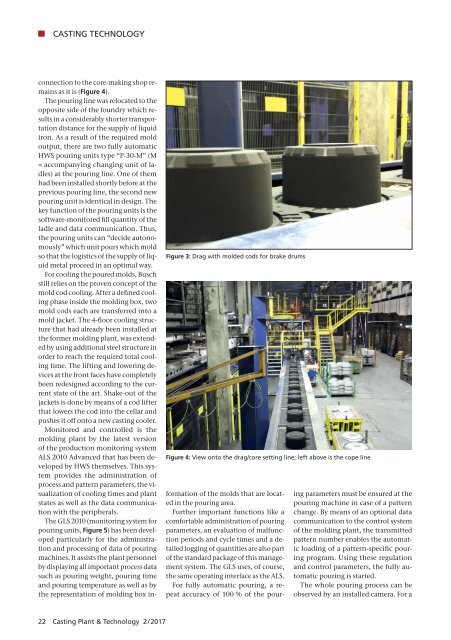CPT International 02/2017
The leading technical journal for the global foundry industry – Das führende Fachmagazin für die weltweite Gießerei-Industrie
The leading technical journal for the
global foundry industry – Das führende Fachmagazin für die
weltweite Gießerei-Industrie
You also want an ePaper? Increase the reach of your titles
YUMPU automatically turns print PDFs into web optimized ePapers that Google loves.
CASTING TECHNOLOGY<br />
Figure 3: Drag with molded cods for brake drums<br />
Figure 4: View onto the drag/core setting line; left above is the cope line<br />
connection to the core-making shop remains<br />
as it is (Figure 4).<br />
The pouring line was relocated to the<br />
opposite side of the foundry which results<br />
in a considerably shorter transportation<br />
distance for the supply of liquid<br />
iron. As a result of the required mold<br />
output, there are two fully automatic<br />
HWS pouring units type “P-30-M” (M<br />
= accompanying changing unit of ladles)<br />
at the pouring line. One of them<br />
had been installed shortly before at the<br />
previous pouring line, the second new<br />
pouring unit is identical in design. The<br />
key function of the pouring units is the<br />
software-monitored fill quantity of the<br />
ladle and data communication. Thus,<br />
the pouring units can “decide autonomously”<br />
which unit pours which mold<br />
so that the logistics of the supply of liquid<br />
metal proceed in an optimal way.<br />
For cooling the poured molds, Busch<br />
still relies on the proven concept of the<br />
mold cod cooling. After a defined cooling<br />
phase inside the molding box, two<br />
mold cods each are transferred into a<br />
mold jacket. The 4-floor cooling structure<br />
that had already been installed at<br />
the former molding plant, was extended<br />
by using additional steel structure in<br />
order to reach the required total cooling<br />
time. The lifting and lowering devices<br />
at the front faces have completely<br />
been redesigned according to the current<br />
state of the art. Shake-out of the<br />
jackets is done by means of a cod lifter<br />
that lowers the cod into the cellar and<br />
pushes it off onto a new casting cooler.<br />
Monitored and controlled is the<br />
molding plant by the latest version<br />
of the production monitoring system<br />
ALS 2010 Advanced that has been developed<br />
by HWS themselves. This system<br />
provides the administration of<br />
process and pattern parameters, the visualization<br />
of cooling times and plant<br />
states as well as the data communication<br />
with the peripherals.<br />
The GLS 2010 (monitoring system for<br />
pouring units, Figure 5) has been developed<br />
particularly for the administration<br />
and processing of data of pouring<br />
machines. It assists the plant personnel<br />
by displaying all important process data<br />
such as pouring weight, pouring time<br />
and pouring temperature as well as by<br />
the representation of molding box information<br />
of the molds that are located<br />
in the pouring area.<br />
Further important functions like a<br />
comfortable administration of pouring<br />
parameters, an evaluation of malfunction<br />
periods and cycle times and a detailed<br />
logging of quantities are also part<br />
of the standard package of this management<br />
system. The GLS uses, of course,<br />
the same operating interface as the ALS.<br />
For fully automatic pouring, a repeat<br />
accuracy of 100 % of the pouring<br />
parameters must be ensured at the<br />
pouring machine in case of a pattern<br />
change. By means of an optional data<br />
communication to the control system<br />
of the molding plant, the transmitted<br />
pattern number enables the automatic<br />
loading of a pattern-specific pouring<br />
program. Using these regulation<br />
and control parameters, the fully automatic<br />
pouring is started.<br />
The whole pouring process can be<br />
observed by an installed camera. For a<br />
22 Casting Plant & Technology 2 / <strong>2017</strong>


















